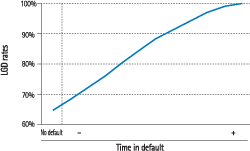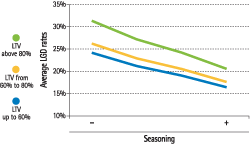Loss given default (LGD) is another of the key risk metrics used in quantitative risk analysis. It is defined as the percentage risk of exposure that is not expected to be recovered in the event of default.
BBVA basically uses two approaches to estimate LGD. The most usual is that known as “workout LGD”, in which estimates are based on the historical information observed in the entity, by discounting the flows that are recorded throughout the recovery process of the contracts in default at any time. In portfolios with a low rate of defaults, there is insufficient historical experience to make a reliable estimate using the workout LGD method, so external sources of information have to be combined with internal data to obtain a representative rate of loss given default.
In general, the portfolios managed by the Bank show bimodal behavior in terms of loss given default: in other words, following default, the recovery of debt is in some cases total and in others, null. The chart below shows the distribution of the LGD of mortgage portfolios in BBVA Spain, filtering out the most recent defaults to prevent the short amount of time to recover to skew results.
The LGD estimates are carried out by segmenting operations according to different factors that are relevant for its calculation, such as the default period, seasoning, the loan-to-value ratio, type of customer, score, etc. The factors may be different according to the portfolio being analyzed. Some of these are illustrated below with examples.
- For contracts already in default, an important factor is default seasoning on the contract. The longer the contract has been in default, the lower the recovery of the debt pending. For the purposes of calculating the expected loss and economic capital, contracts not in default are also imputed a LGD comparable to contracts that have just defaulted.
- The seasoning is the period elapsed from the origination of the contract to the default. This is also relevant, as there is an inverse relationship between LGD and seasoning.
- Loan-to-value ratio: Internal analyses show that LGD depends on the relationship between the amount of the loan and the value of the collateral (loan-to-value, LTV), a characteristic feature of the mortgage portfolio.
- Customer type: In the specific case of financial solutions for corporates, the customer type has proven to be a relevant factor. Therefore, a LGD estimate has been obtained for each size of company: corporations, large companies, SMEs, etc.
- Score: The credit rating of contracts may be used to estimate LGD, as there is a positive correlation between score and LGD.
- Exposure at default (EAD): The exposure of contracts at the time of the default is positively related to LGD.
Progress in building LGD scorings and ratings is becoming increasingly important for adapting LGD estimations to economic and social changes. These estimates allow new factors to be included without losing the robustness of the information and obtain models that are more sensitive to improvements or deteriorations in the portfolio. BBVA has already begun to work on incorporating these modifications in the internal models used.
In the BBVA Group, different LGDs are attributed to the loan book (default and not default), according to combinations of all the significant factors, depending on the features of each product/customer. This can be seen in the accompanying chart “LGD for mortgage loans in BBVA Banco Continental”, in which LGD is explained according to the seasoning of the contract and its LTV.
Finally, it is important to mention that LGD varies with the economic cycle. Hence, two concepts can be defined: long-run LGD (LRLGD), and LGD at the worst moment in the cycle, or Downturn LGD (DLGD).
LRLGD represents the average long-term LGD corresponding to an acyclical scenario that is independent of the time of estimation. This scenario should be applied when calculating expected losses. DLGD represents the LGD at the worst time of the economic cycle, so it should be used to calculate economic capital, because the aim of EC is to cover possible losses incurred over and above those expected.
All estimates of loss given default (LGD, LRLGD and DLGD) are performed for each portfolio, taking into account all the factors mentioned above. However, no LRLGD or DLGD estimates are made in portfolios in which the loss given default is not significantly sensitive to the cycle, as they are recovery processes that cover extended periods of time. Therefore, the isolated situations of the economic cycle are mitigated.
In addition to being a basic input for quantifying expected losses and capital, LGD estimates have other uses for internal management. For example, LGD is an essential factor for price discrimination, in the same way that it can determine the approximate value of a default portfolio in the event of wanting to outsource its recovery or defining which potential recovery actions have the highest priority.






